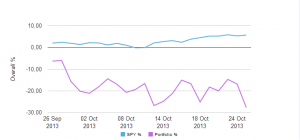The final result of my portfolio: -27.7% of return.
Diagnostic: huge negative result because of try to hold out the bad results in the belief that long term trends would change the results.
This week I tried to make some desperate changes. I cover my wheat position which make me loss great part of my portfolio value; and buy some oat and wheat. But again, was too late to take advantage of the upward trends and quickly these two grains start on lowering prices.
I believe that the reasons of my bad result were two:
First of all, to think that long term tendencies can make you gain profit. As we know, normal backwardation cannot last in time because this could give arbitrage possibilities. And the possibilities of make profit in the market is in quick movements motivated for information asymmetries or good projection of the historical data (technical analysis)
The second reason, and the most important, was the lack of technical analysis during the chain of decisions along this period. The proper utilizations of these skills allow anticipating changes in prices, giving the necessary information to take good decisions.
On synthesis now I understand that the real probability for speculators to generate profit on this is in the systematic machinery of short term decision that make good results of any jump up or down in prices. Off course this machinery requires the skill in technical analysis and the whole overview of markets, but even more important, the desires to have the opportunity of make profit every time that prices move.




